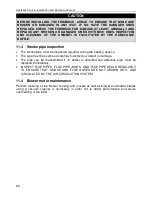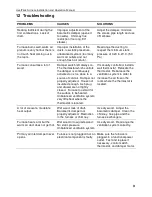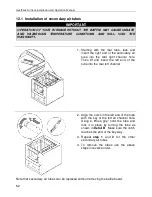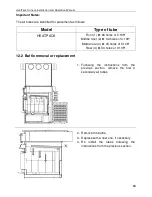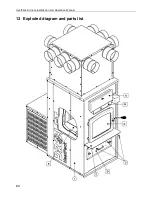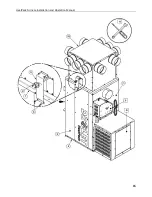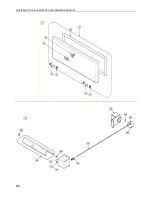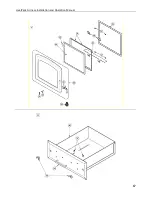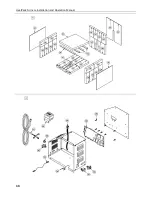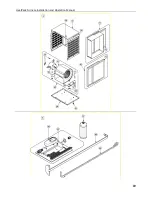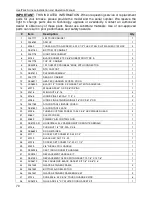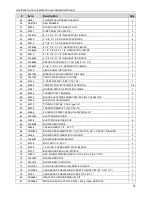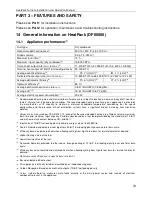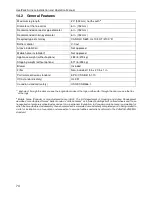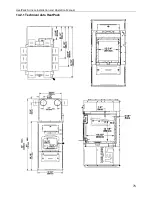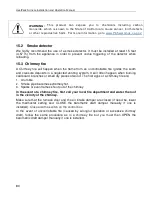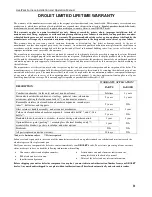
HeatPack Furnace Installation and Operation Manual
73
PART 3 – FEATURES AND SAFETY
Please see
Part 1
for installation instructions.
Please see
Part 2
for operation, maintenance and troubleshooting instructions.
14 General information on HeatPack (DF00500)
14.1 Appliance performance
(1)
Fuel type
Dry cordwood
Recommended heating area
[*]
500 to 1,500 ft² (46 à 139 m²)
Firebox volume
2.3 pi³ (0.057 m³)
Maximum burn time
[*]
13 h
Maximum input capacity (dry cordwood)
(2)
198,000 BTU
Overall heat output rate (min. to max.)
(3)
11,319 BTU/h à 37,053 BTU/h (3.3. kW à 10.8 kW)
Nominal heat output
at 15lb/ft³ fuel loading density
55,000 BTU
Average overall efficiency
(4)
75.7 % (HHV)
(5)
81.1 % (LHV)
(6)
Delivered heat output rate (min. to max.)
(7)
10.849 BTU/h to 36,429 BTU/h (3.2 kW to 10.7 kW)
Average delivered efficiency
(8)
70.6 % (HHV)
(5)
77.2 % (LHV)
(6)
Optimum efficiency
(9)
85.1%
Average particulate emissions rate
(10)(11)
0.841 lb/mmBTU (0.362 g/MJ)
Average CO
(12)
15.61 lb/mmBTU (6.72 g/MJ)
Average electrical power consumption
(13)
302 W
[*]
Recommended heating area and maximum burn time may vary subject to location in home, chimney draft, heat loss
factors, climate, fuel type and other variables. The recommended heating area for a given appliance is defined by
the manufacturer as its capacity to maintain a minimum acceptable temperature considering that the space
configuration and the presence of heat distribution systems have a significant impact in making heat circulation
optimum.
(1)
Values are as measured per CSA B415.1-10, except for the recommended heating area, firebox volume, maximum
burn time and maximum input capacity. Performances based on a fuel load prescribed by the standard at 10 lb/ft³
and with a moisture content between 18% and 28%.
(2)
Input value at 10lb/ft³ fuel loading density and dry energy value of 8,600BTU/lb.
(3)
Overall: Radiated and delivered heat together at10lb/ft³ fuel loading density over one total burn cycle.
(4)
Efficiency based on delivered heat when allowing cycling from high to low burn to simulate thermostat demand.
(5)
Higher Heating Value of the fuel.
(6)
Lower Heating Value of the fuel.
(7)
Delivered: Remotely provided to other rooms through ducting at 10 lb/ft³ fuel loading density over one total burn
cycle.
(8)
Efficiency based on radiated and delivered heat when allowing cycling from high to low burn to simulate thermostat
demand.
(9)
Optimum overall efficiency at a specific burn rate (LHV).
(10)
Based on delivered heat output.
(11)
This appliance is officially tested and certified by an independent agency.
(12)
Carbon Monoxyde. Based on overall heat output at 10lb/ft³ fuel loading density.
(13)
Unless st
ated otherwise, measures were taken directly at the main power source and include all electrical
components present in the appliance.
Summary of Contents for HeatPack DF00500
Page 29: ...HeatPack Furnace Installation and Operation Manual 29...
Page 64: ...HeatPack Furnace Installation and Operation Manual 64 13 Exploded diagram and parts list...
Page 65: ...HeatPack Furnace Installation and Operation Manual 65...
Page 66: ...HeatPack Furnace Installation and Operation Manual 66...
Page 67: ...HeatPack Furnace Installation and Operation Manual 67...
Page 68: ...HeatPack Furnace Installation and Operation Manual 68...
Page 69: ...HeatPack Furnace Installation and Operation Manual 69...
Page 75: ...HeatPack Furnace Installation and Operation Manual 75 14 2 1 Technical data HeatPack...
Page 76: ...HeatPack Furnace Installation and Operation Manual 76...


